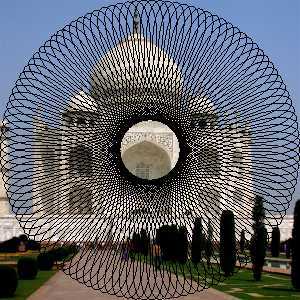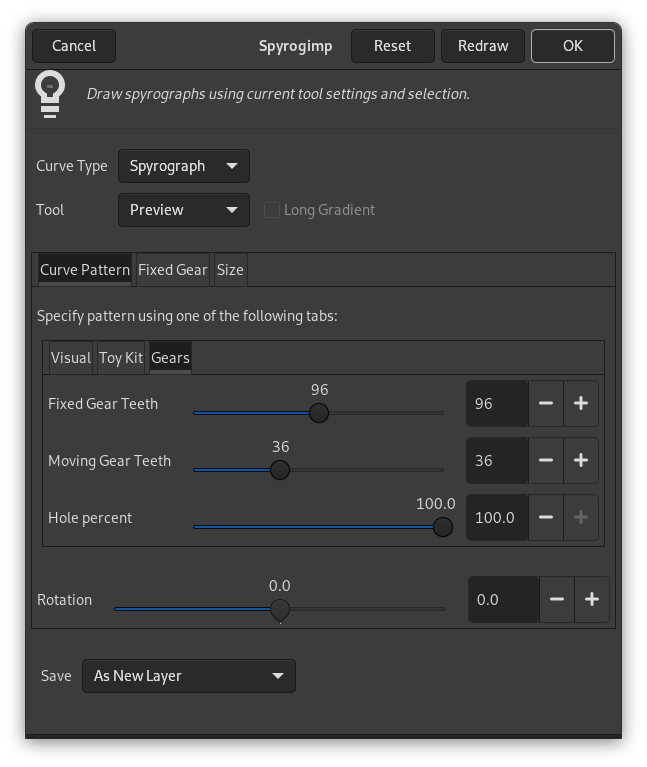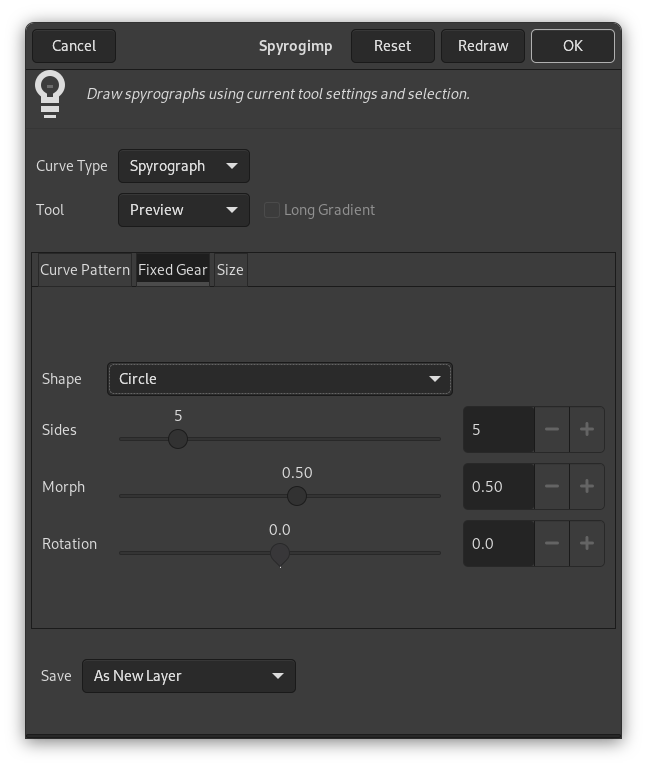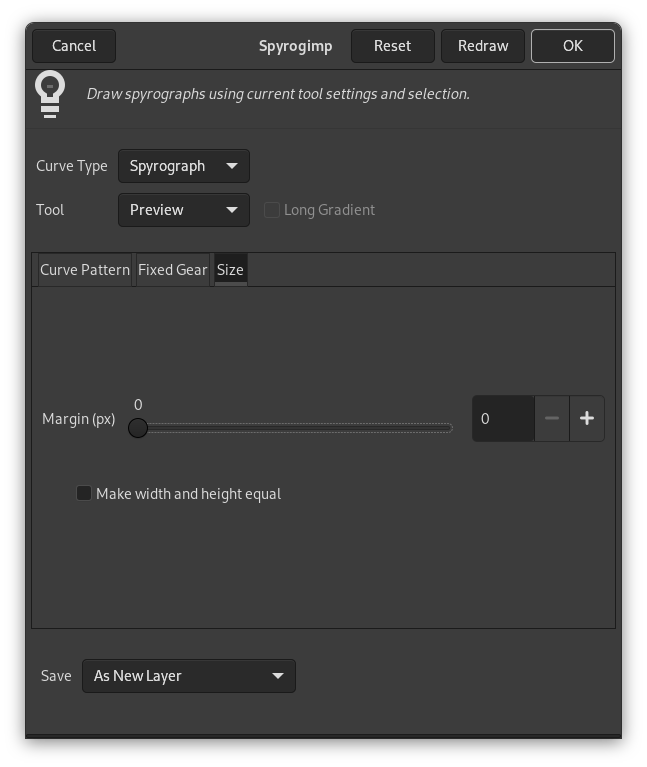Questo filtro disegna spirogrammi, epitrocoidi, e curve di Lissajous. Viene fornito feedback immediato mediante il disegno su un livello temporaneo.
It reproduces curves drawn by Spirograph© toys. Here is an example from Wikimedia Commons showing what gears and holes are:
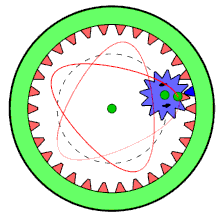
La Rotella mobile è dentro la rotella fissa e viene usato solo un foro.
Much of the behavior of the plug-in is determined by options set outside of the plug-in, such as the current selection, or the settings of GIMP's tools. These settings can be changed while the plug-in is running.
![[Nota]](images/note.png)
|
Nota |
|---|---|
|
In contrast to options within the plug-in, changing the current selection or tool settings will not redraw the pattern. To show the changes, click the button at the bottom of the plug-in. |
As in most plug-ins, the current selection determines the area where the pattern will be rendered. Typically, this would be a rectangular selection. There is however, an additional way the selection can be used.
The selection can be used as the shape of the fixed gear (under the Fixed Gear tab). The plug-in will attempt to extract shapes from the selection, and draw a pattern inside of each shape. This is more interesting if you select a non-rectangular selection.
Per avere il motivo che abbraccia i bordi delle forme, usare Percentuale foro=100.
Spyrogimp uses GIMP's tools to perform the drawing. All the settings with which the drawings are done are taken from the chosen tool. For example, if you want to use the Pencil tool (by choosing it from the Tool menu), then all the settings of this tool will be used for drawing. You can change any of the tool settings while the plug-in is running, and press the button to see how the pattern looks.
Molte delle opzioni sono organizzate in tre schede: Motivo curva, Rotella fissa, e Dimensione.
- Tipo curva
-
The available curve types are: Spyrograph, Epitrochoid, Sine, and Lissajous. These correspond to physical models for drawing them, using either gears or springs. Spyrograph and Epitrochoid curves are obtained by using two gears - a fixed gear, and a moving gear. A Spyrograph pattern is obtained when the moving gear is rotated inside the fixed gear. When the moving gear is outside the fixed gear, an Epitrochoid pattern is generated. The Sine curve uses the fixed gear, but instead of a moving gear, there is a spring that moves perpendicular to the fixed gear's edge. The Lissajous curve is generated by two springs, which move on the x and y axis. It does not use the fixed ring at all, and thus is not affected by changing it.
Figura 17.412. Tipi di curve «Spirogimp»

Tipi di curve da sinistra a destra: Spirografo, Epitrocoide, Seno e Lissajous.
- Strumento
-
The GIMP tool with which to draw the pattern. The first tool is named Preview and its purpose is to draw quickly, rather than beautifully - so the pattern can be previewed. The other available tools are: PaintBrush, Pencil, AirBrush, Stroke, Ink, and MyPaintBrush.
- Gradiente lungo
-
When unchecked, the current tool settings will be used - this can either produce a gradient or not, depending on the tool settings. When checked, the plug-in will produce a long gradient to match the length of the pattern, based on the current gradient, the "Reverse" setting, and the Repeat mode from the gradient tool settings. Setting the Repeat mode to Triangle Wave will produce a pattern that changes continuously, with no abrupt breaks. This is done by using the gradient followed by its reverse. Any other Repeat mode will simply use the gradient from start to finish.
Figura 17.413. Esempi di gradiente lungo in «Spirogimp»

The left image, without Long Gradient, used the paintbrush tool with a gradient. The two right images were generated with the same gradient, but with Long Gradient checked. The right image used the Triangle Wave Repeat mode.
Figura 17.414. Opzioni del filtro «Spirogimp» (Motivo curva)
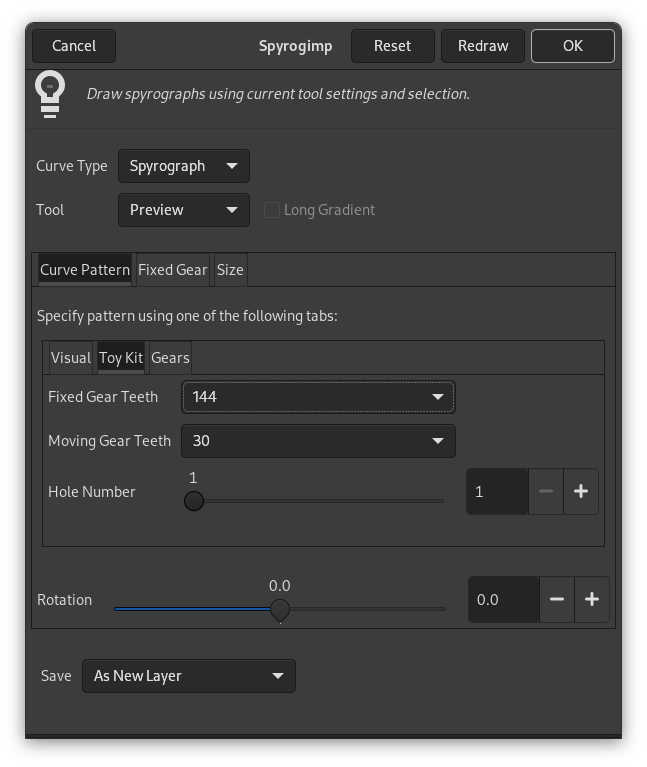
La scheda interna Kit giocattolo viene mostrata sulla destra.
Specifica un motivo usando le schede Rotelle, Kit giocattolo o Visuale. Il motivo si basa solo sulle impostazioni della scheda attiva. Il Kit giocattolo è simile a Rotelle, ma usa rotelle e numeri di foro che si possono trovare appunto nei kit giocattolo. Se si seguono le istruzioni descritte nei manuali dei suddetti kit, si dovrebbero ottenere risultati simili.
- Denti rotella fissa
-
Numero di denti della rotella fissa. La dimensione della rotella fissa è proporzionale al numero di denti.
- Denti rotella mobile
-
Numero di denti della rotella mobile. La dimensione della rotella mobile è proporzionale al numero di denti.
- Percentuale foro
-
Quanto è distante il foro dal centro dalla rotella mobile. 100% significa che il foro è sul bordo della rotella.
Anche la scheda Kit giocattolo possiede le opzioni Denti rotella fissa e Denti rotella mobile. Ma in questo caso sono limitati alle dimensioni delle rotelle fornite con i kit giocattoli per il disegno degli spirogrammi.
- Numero foro
-
Il foro n°1 è sul bordo della rotella. Il numero foro massimo è vicino al centro. Il numero foro massimo è diverso per ogni rotella.
Figura 17.415. Esempi del Kit giocattolo di «Spirogimp»
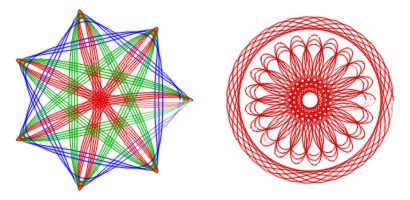
Il Kit giocattolo serve a ricreare i disegni fatti con il vero giocattolo. L'immagine a sinistra usa una rotella fissa a 105 denti, e delle rotelle mobili a 30 (blu), 45 (verde) e 60 (rossa) denti, e ogni rotella mobile è stata usata diverse volte con Numero foro variabile tra 3 e 7. L'immagine destra usa anch'essa la rotella fissa da 105 denti, con quella mobile da 24 (numero foro 4), e da 80 (numeri foro 16, 18, 20).
Figura 17.416. Opzioni del filtro «Spirogimp» (Motivo curva)
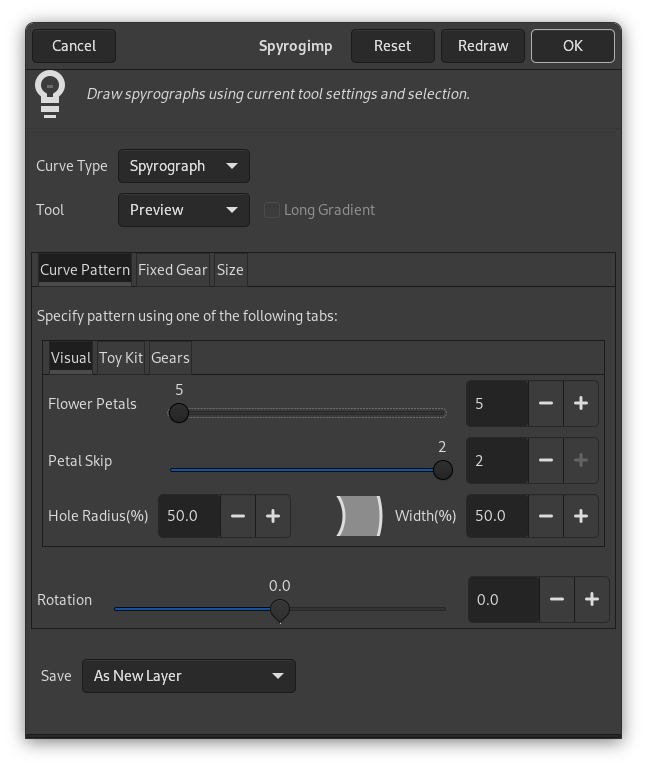
La scheda Visuale viene mostrata a metà altezza sulla destra.
La scheda Visuale crea motivi a petali di fiore arrotondati. Ha le seguenti impostazioni:
- Petali di fiore
-
Il numero di petali di fiore da disegnare.
- Salta petalo
-
Il numero di petali di fiore da saltare.
- Raggio foro (%)
-
La dimensione del foro.
- Larghezza (%)
-
La larghezza del disegno.
Sotto le schede c'è un'opzione aggiuntiva.
- Rotazione
-
Rotazione del motivo, in gradi. La posizione iniziale della rotella mobile nella rotella fissa. Si noti che questa cambia anche il motivo se si disegnano curve di Lissajous.
- Forma
-
La forma della rotella fissa da usare all'interno della selezione corrente.
-
Cerchio
-
Rack is a long round-edged shape provided in the toy kits.
-
Frame hugs the boundaries of the rectangular selection, use hole=100 in Gear notation to touch boundary. To generate a narrow frame width, use a small number of teeth for the moving gear.
-
Selection will hug boundaries of current selection - try something non-rectangular.
-
Polygon-Star morphs from an n-sided polygon (morph=0) to an n-sided star (morph=0.3) to a crazy flower (morph=1).
-
Sine with morph=0, it is just like a circle, but becomes more wavy as morph increases.
-
Bumps morphs from a polygon (morph=0) to a scalloped circle.
Figura 17.418. Esempi di curve in «Spirogimp»

From left to right, Circle, Rack, Frame, and Selection shapes of the fixed gear. The selection in the right image was generated by selecting a large letter "T" that was produced by the text tool.
Figura 17.419. Esempi di forma Stella-poligono in «Spirogimp»

Da sinistra a destra, Metamorfosi = 0, 0.3, 0.6, 1
Figura 17.420. Esempi di curve Sinusoidali in «Spirogimp»

Da sinistra a destra, Metamorfosi = 0.1, 0.3, 0.5
Figura 17.421. Esempi di forme di rigonfiamenti in «Spirogimp»

Da sinistra a destra, Metamorfosi = 0, 0.5, 1
-
- Lati
-
Numero di lati della forma.
This applies only to the Polygon-Star, Sine, and Bumps shapes. Otherwise this option is disabled.
- Metamorfosi
-
Morph fixed gear shape.
This applies only to the Polygon-Star, Sine, and Bumps shapes. Otherwise this option is disabled.
- Rotazione
-
Rotazione della rotella fissa, in gradi.
- Margine (pixel)
-
Margine dal bordi della selezione. Controlla la dimensione del motivo.
- Rende larghezza e altezza uguali
-
Se non selezionata, il motivo riempirà l'immagine o la selezione correnti. Se selezionata, il motivo avrà la stessa larghezza e altezza, e verrà centrata. La differenza tra selezionata e deselezionata verrà notata solo nel caso la dimensione della larghezza e altezza della selezione siano diverse.
- Salva
-
Il menu a discesa Salva determina cosa accadrà al livello temporaneo una volta premuto . Le opzioni disponibili sono: Come nuovo livello, Ridisegna sull'ultimo livello attivo e Come tracciato.
- Ridisegna
-
If you change the settings of a tool, change color, or change the selection (i.e., any settings outside of the plug-in that affect the pattern), press this to update the preview to see how the pattern looks.
- Reimposta
-
Reimposta la finestra alle opzioni predefinite.
- Annulla
-
Cancella il livello temporaneo ed esce dal plugin.
- OK
-
Renderizza il motivo all'immagine.
